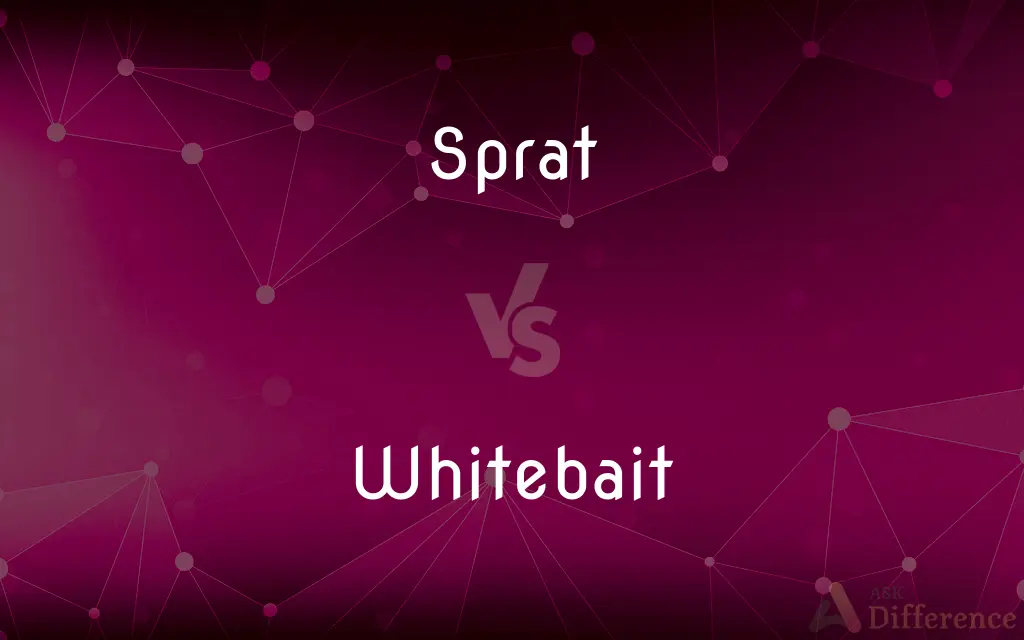Sprat vs. Whitebait — What's the Difference?
By Tayyaba Rehman & Fiza Rafique — Updated on April 5, 2024
Sprat is a specific type of small fish, known for its role in marine ecosystems, whereas whitebait refers to juvenile fish of various species, often used as a culinary delicacy.

Difference Between Sprat and Whitebait
Table of Contents
ADVERTISEMENT
Key Differences
Sprats are small, herring-like fish found in European seas, forming significant parts of the marine food web and known for their oily flesh. Whitebait, on the other hand, encompasses the immature fry of multiple fish species, including herring and sprat, and is prized for its delicate flavor when cooked.
While sprats are identified as a specific species, belonging to the genus Sprattus, whitebait is a generic term that includes the young of sprats, herring, and several other types of small fish. This distinction is important in culinary contexts, where whitebait can vary in taste and texture based on the mix of species it contains.
Sprats are often marketed and consumed whole, sometimes canned or smoked, offering a distinct, rich flavor profile. Conversely, whitebait is typically served fresh, lightly breaded and fried, celebrated for its tender texture and subtle taste, making it a popular dish in various cuisines.
In terms of fishing and sustainability, sprats are subject to specific regulations aimed at preserving stocks and ensuring the health of marine ecosystems. Whitebait fishing, however, has raised concerns over the impact on fish populations, as it involves catching very young fish before they have a chance to reproduce.
Both sprats and whitebait play important roles in their respective contexts: sprats as a species with ecological and commercial significance, and whitebait as a culinary term that denotes a variety of young fish used in cooking. Their differences highlight the complexities of marine life and the culinary traditions that surround them.
ADVERTISEMENT
Comparison Chart
Definition
A specific type of small, oily fish.
Juvenile fish of various species, used as a culinary delicacy.
Species
Belongs to the genus Sprattus.
Includes young of sprats, herring, and others.
Culinary Use
Consumed whole, canned, or smoked.
Served fresh, typically breaded and fried.
Flavor Profile
Distinct and rich.
Delicate and subtle.
Sustainability
Subject to fishing regulations.
Fishing raises concerns over impact on fish populations.
Compare with Definitions
Sprat
An important part of marine food webs.
Sprats serve as a crucial link in the ecosystem, feeding on plankton and being prey for larger species.
Whitebait
Can include young herring, sprats, and other small fish.
The composition of whitebait can vary greatly, affecting its taste.
Sprat
Often eaten whole and preserved in various ways.
In many cultures, canned sprats are a traditional snack.
Whitebait
Favored for its tender texture and mild flavor.
Freshly fried whitebait is a delicacy in coastal areas.
Sprat
Fishing is regulated to protect sprat populations.
Sprat fishing quotas are implemented to ensure sustainability.
Whitebait
Fishing practices have ecological impacts.
The capture of whitebait at a young age threatens fish populations.
Sprat
A small, herring-like fish known for its oily flesh.
Sprats are a popular choice for smoking due to their rich flavor.
Whitebait
Served in various cuisines as a prized ingredient.
Whitebait is often featured in seasonal menus and specialty dishes.
Sprat
Known for their distinct, rich taste.
The sprat's oily flesh contributes to its flavorful profile.
Whitebait
Juvenile fish of various species, considered a delicacy.
Whitebait fritters are a cherished dish in some regions.
Sprat
Sprat is the common name applied to a group of forage fish belonging to the genus Sprattus in the family Clupeidae. The term also is applied to a number of other small sprat-like forage fish (Clupeoides, Clupeonella, Corica, Ehirava, Hyperlophus, Microthrissa, Nannothrissa, Platanichthys, Ramnogaster, Rhinosardinia, and Stolothrissa).
Whitebait
Whitebait is a collective term for the immature fry of fish, typically between 1 and 2 inches (25 and 50 mm) long. Such young fish often travel together in schools along the coast, and move into estuaries and sometimes up rivers where they can be easily caught with fine meshed fishing nets.
Sprat
Any of various small marine food fishes of the genus Sprattus, especially S. sprattus of the northeast Atlantic Ocean and the Mediterranean and Baltic Seas, eaten fresh or smoked and often canned as a sardine. Also called brisling.
Whitebait
The small silvery-white young of herrings, sprats, and similar marine fish, eaten in numbers as food.
Sprat
Any of various other fishes of the family Clupeidae, such as a young herring.
Whitebait
The young of various fishes, especially the herring, considered a delicacy when fried.
Sprat
Any of various small, herring-like, marine fish in the genus Sprattus, in the family Clupeidae.
Whitebait
The young of various species of fish, especially herrings, sprats or smelts
Sprat
Any of various similar fish of other genera.
Whitebait
Food prepared from such fish, often deep fried and served as a starter or snack.
Sprat
(by extension) Anything petty or insignificant.
Whitebait
(intransitive) To fish for whitebait.
Sprat
A sixpence.
Whitebait
The young of several species of herrings, especially of the common herring, esteemed a great delicacy by epicures in England.
Sprat
A small European herring (Clupea sprattus) closely allied to the common herring and the pilchard; - called also garvie. The name is also applied to small herring of different kinds.
Whitebait
Minnows or other small fresh- or salt-water fish (especially herring); usually cooked whole
Sprat
Small fatty European fish; usually smoked or canned like sardines
Whitebait
The edible young of especially herrings and sprats and smelts
Sprat
Small herring processed like a sardine
Common Curiosities
How are sprats consumed?
Sprats are typically consumed whole, either canned, smoked, or fresh, appreciated for their rich flavor.
Can whitebait include sprat juveniles?
Yes, whitebait can include juvenile sprats among other species, contributing to its varied taste and texture.
What is sprat?
Sprat is a small, oily fish, belonging to the genus Sprattus, valued both ecologically and as a food source.
What is whitebait?
Whitebait refers to the juvenile stages of various small fish species, often used as a culinary delicacy.
Is there a difference in taste between sprat and whitebait?
Yes, sprat has a distinct, rich taste, while whitebait is prized for its more delicate and subtle flavor profile.
Why is whitebait considered at risk?
Whitebait is considered at risk due to the indiscriminate nature of fishing practices, which can deplete young fish before they reproduce.
Are sprats and whitebait sustainable?
While sprat fisheries are regulated to ensure sustainability, whitebait fishing faces scrutiny for its potential impact on fish populations.
How should whitebait be cooked?
Whitebait is best cooked fresh, lightly breaded, and quickly fried to preserve its delicate flavor.
What makes whitebait a delicacy?
Whitebait is considered a delicacy due to its tender texture and subtle flavor, often served breaded and fried.
Can sprats be eaten raw?
While sprats are typically canned, smoked, or cooked, consuming any raw fish carries risks and should be done with caution.
What are the concerns with whitebait fishing?
Concerns with whitebait fishing revolve around the sustainability and ecological impact of capturing juvenile fish.
Why are sprats important to marine ecosystems?
Sprats play a crucial role in marine ecosystems by linking plankton with larger predators, supporting biodiversity.
What are the benefits of eating sprats?
Sprats are rich in omega-3 fatty acids and other nutrients, offering health benefits similar to other oily fish.
What can be done to make whitebait fishing more sustainable?
Sustainable whitebait fishing may involve stricter regulations, seasonal closures, and conservation efforts to protect juvenile fish stocks.
How do regulations affect sprat fishing?
Regulations aim to ensure the sustainable harvest of sprats, protecting their populations and the marine environment.
Share Your Discovery

Previous Comparison
Plinth vs. Pedestal
Next Comparison
Different vs. SeparateAuthor Spotlight
Written by
Tayyaba RehmanTayyaba Rehman is a distinguished writer, currently serving as a primary contributor to askdifference.com. As a researcher in semantics and etymology, Tayyaba's passion for the complexity of languages and their distinctions has found a perfect home on the platform. Tayyaba delves into the intricacies of language, distinguishing between commonly confused words and phrases, thereby providing clarity for readers worldwide.
Co-written by
Fiza RafiqueFiza Rafique is a skilled content writer at AskDifference.com, where she meticulously refines and enhances written pieces. Drawing from her vast editorial expertise, Fiza ensures clarity, accuracy, and precision in every article. Passionate about language, she continually seeks to elevate the quality of content for readers worldwide.














































